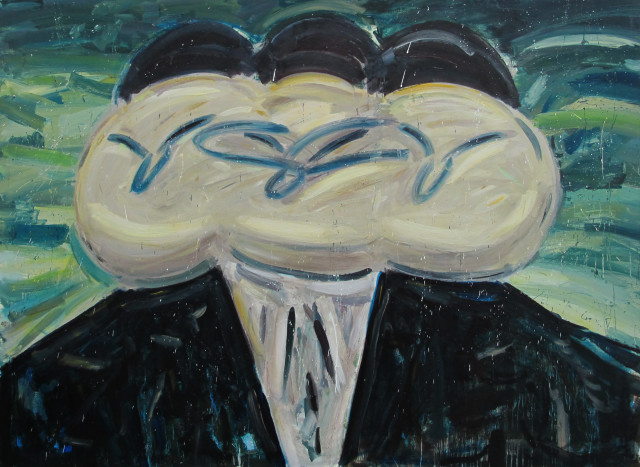It’s a Neo-expressionist trip that Iranian Amir Khojaesteh’s newest series The Gloomiest Sunset in the World takes viewers on—an ominously tinted journey through thick layers of gestural paint strokes that reference Georg Baselitz, Willem de Kooning or Edvard Munch. But his influences are treated with a twisted humour and jaded nonchalance that suggests that if these portraits had sound, it’d be of muted laughter bouncing within a sound-warped chamber.
Real characters and historical artworks— notorious dictators, Warhol’s screen-printed bovine and Matisse’s compositional equilibrium—serve as first- and second-hand resources recontextualised into absurdity. Intentional ‘bad painting’ is as central to Khojasteh’s practice as prismatic colour, which he manipulates to emphasise expression over the finesse of the graphic design and illustration fields that he worked within previously. It may appear that the alternately bulbous, stretched and whiplashed visages are impulsively subjective and removed from academic or intellectual deconstruction, but his methodology is acute: Khojasteh draws until he mimetically reproduces the image in his mind. These hyperbolised faces in sweeping, inertia-ridden flashes are not artistic whim, rather, studied exercises in a skilled dichotomy of composing caricatures without the innocence—reinforced by that use of hue. Those dark blues, yellows and rich reds read sallow or chaotic, but without frailty.
Following a global refocus on classical portraiture, Khojasteh’s works pay homage to tradition through fleshy satire. Zany, political, phantasmagoric, historic and unavoidably relevant, his body of work engages multiple faculties and epochs, distorted just enough that the line between fantasy and reality leaves viewers in a delicately malevolent twilight zone. Khojasteh prefers the uncanny over exposing inner-workings and objective truths. Instead, he proposes ambiguous alternatives where minds tinker with portraiture as a vehicle to capture subjective interpretations of history, media and the now. It is an opportunity to depict candid opinions without words, a safe space where oscillating jest, dejection and antagonism represent the human condition as a combination of anarchy and fatigue. Not unlike the mixed, contradictory feelings that a sunset induces, which in Persian culture denotes a dualistic moment of sadness and suspension. Khojasteh’s paintings, born of this heritage, embody what he considers humanity’s transformation into comedic tragedy. The Gloomiest Sunset in the World, indeed
— By Katrina Kufer, April 2019
The Gloomiest Sunset in the World: Amir Khojasteh | Solo Exhibition
Past exhibition
15 May - 19 September 2019

